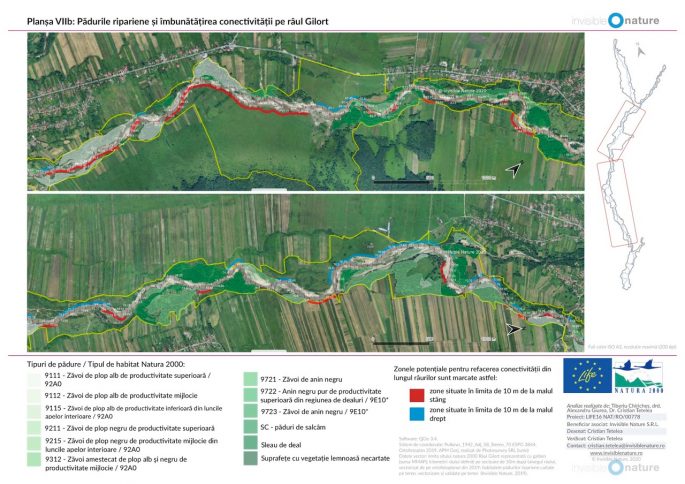We were telling you a while ago about the completion of the A2 activity of the projectnamely the integrated analysis of the Gilort River. One of the most important chapters of the report is aimed at restoring natural habitats on the rivers of the Natura 2000 site, the Gilort River.
The Riparian forests of the Natura 2000 Site, the Gilort River, also face a relatively high degree of fragmentation, which often requires plantings that increase the afforestation of deficient areas and restore the connectivity of these forest bodies. Other threats identified to forests are illegal logging, intensive grazing and the presence of invasive species.
In order to identify the best opportunities for the restoration of natural habitats, the Invisiable Nature team carried out in the first phase a series of analysis of the susceptibility of the area, namely:
- Mapping riparian forest vegetation,
- Updating the forest vegetation map with areas that were not considered typical forest habitats,
- Establishment of buffer zones along the Gilort and Galbenu rivers of 10 m from the shore,
- Identification of potential planting land – areas not covered by vegetation and located in the current active meadow,
- Selection of potential land for planting (falling within the 10 m of the shore and not covered by vegetation),
- Prioritizing potential planting land by considering the degree of erosion of the banks,
- Selecting the best areas that contribute to improving the connectivity of riparian forest habitats along the river sector, but also that can be integrated with shore stabilisation measures.
On the basis of the cartographic data provided by EPA Gorj, obtained courtesy of the local town hall, the landowners in the area of Bengesti commune were also identified. The results of the analyses and potential areas for work to restore the connectivity of riparian forests are exemplified in the chart below.
Of all potential areas for the restoration of riparian natural habitats, a total of 3 ha will be selected along the river through a collaborative process with the landowners, who must give their consent and maintain these new planted areas until the massive state of the plantation.
As far as possible, native species of saplings and seed, selected from local nurseries or collected from along the river, will be planted. The composition of the planted trees will follow the composition of the natural type of forest or the locally identified natural habitats, in order to ensure a natural continuity of riparian forest vegetation in an irregular planting scheme.
Access of domestic animals to planted areas will be restricted in order to reduce the risk of grazing or destruction by animals. Where appropriate, control measures shall be taken for invasive species in adjacent perimeters until the massive state in the plantation is closed. This involves tracking the evolution of these species and manually removing invasive species.


